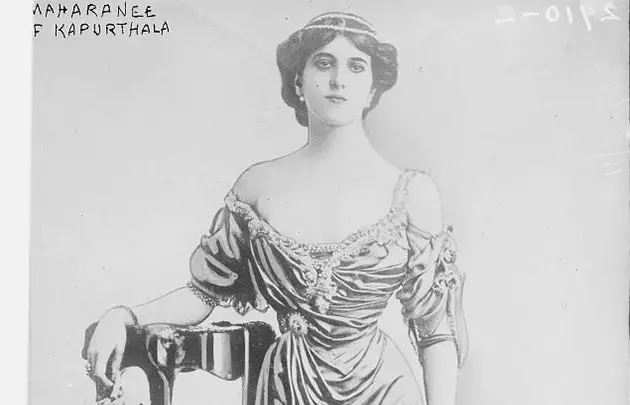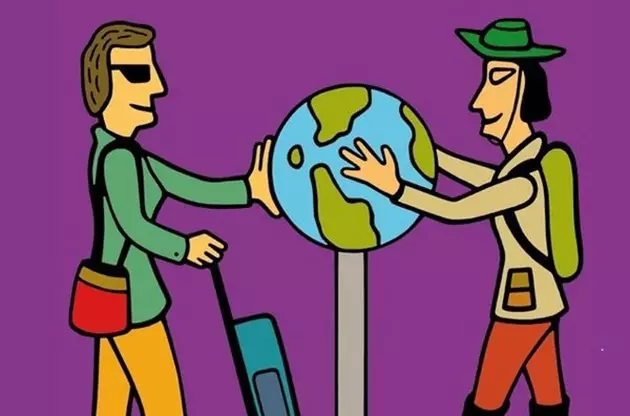
Anita Delgado-Briones
EGERIA (OR ETARIA), THE FIRST GLOBETROTTER
“ The first Spanish travel book was written by a woman, Egeria, a thousand years ahead of Marco Polo ”, writes the journalist Cristina Morató in ** Travelers, intrepid and adventurous ** (Plaza&Janés). For three years, between 381 and 384, the Galician abbess (or from the south of France, according to other sources) traveled with a Bible to contrast it with the places that she was discovering : Constantinople, Mesopotamia, Jerusalem, Mount Sinai or Egypt.
Egeria was a cultured woman (she knew geography and Greek), curious and daring who took advantage of the Pax Romana and the 80,000 kilometers of the Empire's roads to undertake her own adventure. “On her pilgrimage, the traveler she wrote a series of letters to her friends and family describing everything they saw in her astonished eyes ” - comments Cristina Morato to Condé Nast Traveler- “in 1844 the Egeria letters came to light and the world discovered with surprise that this fresh, simple story full of subtle observations had been written by a woman ”.
There is evidence of the explorations and anecdotes of this pioneering pilgrim (such as the fact that she had protection in certain places or the time she traveled with a very stubborn guide ) in "a text where" -highlights Morató- "the author narrates her epic adventure without mentioning the dangers or the inconveniences she had to face, she does not even give importance to the fact that she may not return alive from such a hard journey ”.
ISABEL BARRETO, THE FIRST ADMIRAL
“She was the first female admiral in the history of Spain, in the time of Philip II” -recalls Morató- “ a brave and armed woman to take on the height of Magallanes and Orellana ”. Although she was born in Pontevedra in 1567, when she was a child she moved with her family to the Viceroyalty of Peru where she married the navigator Álvaro de Mendaña. Her noble origin and her upbringing ( she understood latin and knew how to write ) allowed her to move in restricted environments for women.
Her feat begins in 1595 when she decides to accompany her husband on her second voyage, on an expedition across the Pacific. “During her journey, her husband Álvaro de Mendaña died, and she assumed command of the expedition that had left Peru in search of the Solomon Islands , where they believed there was a kingdom of gold and precious stones”, says Morató. It was not an easy route: while she jealously guarded her supplies “the situation in which the crew found themselves was deplorable, there was hardly any water or food, most were sick and not a day went by without three or four corpses being thrown into the sea ”, recalls Morató.
She faced epidemics, riots and hardships but she managed to reach Manila in 1596, where she was received with all the honors . Sometimes portrayed as cruel and capricious, Morató defines her as an extraordinary woman "before her death, her husband appointed her Adelantada and Governor because she did not doubt his abilities ”.
INES SUAREZ, VALUE WITHOUT BORDERS
Inés Suárez was born in Plasencia (1507) where she worked as a seamstress. In 1537 and in the company of her niece, she embarked for the Indies in search of her husband Juan de Málaga, who had left for Venezuela in search of fortune a year before . Following her trail, she left Venezuela for Peru where she discovered his death.
Finding herself alone in Cuzco she decided not to return to Spain . "There she meets the Extremaduran captain Pedro de Valdivia, who is preparing an expedition to undertake the conquest of Chile" -explains Morató- "she decides to enlist in his company and she travels with him as a maid, yes, attending to the sick, confronting the Mapuche Indians , fighting as a soldier and acting as a veteran strategist." She was awarded land and a commission by the king, she crossed the Atacama desert her bravely and participated in the defense of Santiago de Chile, a city from which she was governor when she married captain Rodrigo de Quiroga.
CATALINA DE ERAUSO, A MAN IN BATTLE
"There were other women who performed great feats and who are perhaps better known, like the nun Ensign , actually called Catalina de Erauso, woman of quarrelsome and violent character; she entered as a girl in a convent from which she escaped when she was fifteen years old disguised as a man "-remembers Cristina Morato -. After wandering through Bilbao and Valladolid, she reached Sanlúcar de Barrameda. From there she left for America where she fought as an infantryman in Peru and Chile until acquiring the rank of lieutenant. He maintained a masculine identity practically until the end of his days. (and he obtained permission from Pope Urban VIII to continue dressing as a man). He lived a life full of travel, battles, arrests and escapes.
ENTREPRENEURS, FEARLESS AND CONQUERING
There are not a few names of women who, during the 16th century, left behind a secondary role, subservient to men and without intellectual relevance. This is the case for the following browsers:
- Mencia Calderon, a woman who crossed 1,600 kilometers of rivers, mountain ranges and jungle, in front of fifty women , in an expedition that lasted six years.
- The governor of Guatemala and the viceroyalties, Beatrice of the Cave , chosen by her husband's soldiers to direct her destiny.
- Mencia Ortiz , the founder of a freight transport company to the Indies in 1549.
- Mary Escobar , the pioneer woman who introduced and cultivated wheat in America.
The trip meant for them to be protagonists of their own story.
EMILIA SERRANO, JOURNALIST AND TRAVELER
“ They are two very interesting figures, who had lived and traveled intensely , earning a living with her pen and overcoming many of the obstacles that women of the time encountered to survive as intellectuals ” -says Beatriz Ferrús, PhD and full professor in Hispano-American Literature at the Universitat Autònoma de Barcelona and author of the research Women and travel literature in the 19th century: between Spain and the Americas - “I got to both thanks to Dr. Carmen Simón from the CSIC, author of the pioneering book Spanish women writers of the 19th century: Bio-bibliographical manual ”.
** Emilia Serrano García ** (also known as Emilia Serrano de Wilson) was a journalist, writer and poet born in Granada in 1843 and educated in Paris. A woman that traveled all over America, from Canada to Patagonia her for 30 years. She founder and director of several publications in Havana, Lima or Mexico, her texts pick up the pulse of the protagonists of her time.
In America and her women , for example, she recounts scenes of navigation, the crossing of the Isthmus of Panama or routes through the peaks of the Andes on the back of a mule ; a tribute to all the Hispanic American women she met and her informal and supportive network to promote her literary and intellectual aspirations.
“(…) She has made dangerous journeys... No woman has ever done such arduous work or undertaken an undertaking of such magnitude. For much less, trips by French and English women have been applauded, celebrating her efforts in all tones. And these trips have not been for tourists, they have been of a studious, industrious woman , who has worked tirelessly, ”the journalist wrote about her Carmen de Burgos (known by her pseudonym Colombian ) .
EVA CANEL, A TIRELESS VOICE
The Asturian writer and journalist Eva Canel she also toured South America: first to meet her husband (the Director of the satirical magazine The joke , banished after publishing a censored pamphlet), and later to earn a living as a "lecturer". After traveling to Uruguay, Buenos Aires and Bolivia her, she arrived in Peru where she collaborated with Emilia Serrano in The Pacific Weekly (which they edited in her own house). Emilia Serrano was the godmother of her only son.
Conservative in her personal life, her texts show us an adventurous, open and entertaining vision of her routes, such as the description of the peasantry of the steamship Aconcagua of the English Pacific Company in Things from the other world. American Travels, Histories, and Tales.
Eva Canel filled auditoriums in Chile, Peru, Cuba, Mexico, Panama, Brazil, Argentina, Uruguay... This is how the researcher Carmen Simón collects her words in her article Eva Canel, lecturer traveling through America : “They have applauded me more than necessary; They have flattered me without rate or measure, exaggerating the merits, realizing then that They had a woman in front of them, but before they 'soaked' me like melons Nobody had granted me those extraordinary favors that are granted to documented or undocumented charlatans”.
There are many women waiting for their well-deserved recognition, " we still have to reconstruct the 'history of women' and recover their voices ", says Beatriz Ferrús.
CHALLENGES: THE TRAVELING WOMAN
With the purpose of connecting and strengthening the relationship between women from all over the world, the Madrid Alice Fauveau created a single agency Focus On Women .
From the hand of Cicero What Rosa Maria Calaf (“I thought, I want to be like her!” recalls Fauveau) or the travel journalist Elena of the Master , Focus on Women proposes discovering the world by approaching the lives of doctors, athletes, researchers, farmers, musicians, writers ... that carry out very interesting projects.
"Imagine seeing the reality of women in an Islamic country, for example, that a woman tells you what the Koran says about women," explains Fauveau. Five years after the birth of this project, 6,700 women have participated as travelers, guides or locals..
If you are thinking about your next adventure, female travelers (The traveling editorial) will provide you with information to prepare your route alone (or alone) thanks to the testimonies of traveling women willing to solve all your doubts.
Follow @merinoticias
*** You may also be interested in...**
- They did it before you: our favorite travelers in history
- Authentic 21st century explorers
- The ten most desirable natural parks in the world
- Travel in search of nothing: a route with the hunter of the ruins of the 20th century
- Reflections from the top of the world
- Sri Lanka, a centuries-old tea plantation
- All the articles of Maria Crespo

Travelers. The manual to prepare your trips and launch yourself to discover the world.
